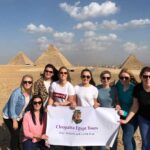Sohag City:
An agricultural town and commercial center, Sohag have a large Coptic Christian community and, like many other cities in Middle Egypt, is a place of sporadic unrest. Although the atmosphere is less tense than in Asyut,
Sohag is not recommended as a place to stay. However the Egyptian government wants to encourage tourists, and a new 6-hectare (15-acre) tourist village is being built on Araman island in the Nile, opposite the city.
A museum is also planned to house archaeological finds from the area. A large animal market is held in the town each Monday.
White Monastery
Short drive west of Sohag, the White Monastery (Deir al-Abyad) dates from the early 5th century AD. Named for the color of its masonry, the monastery was built by the Coptic saint Shenouda using chunks of white limestone taken from local Pharaonic temples.
The monastery was once home to 2,000 monks. Today little remains within its high fortress walls apart from a church dedicated to its founder. On 14th July every year, thousands of pilgrims attend a moulid at the site.
Red Monastery
Four kilometers (2.5 miles) north of the White Monastery lies the Red Monastery (Deir al-Ahmar). Built in the 6th century AD by Shenouda’s disciple Bishoi – a repentant robber who became a saint -the monastery has two churches within its grounds.
The main church contains several interesting, though faded, 10th-century wall paintings. The monastery is hidden within a sprawling village so it may be necessary to ask for directions.
On the eastern bank of the Nile, just across the river from Sohag, is Akhmim, which can be reached by microbus.
The town is known for its hand-woven hangings and carpets. The town’s main attraction, an 11-m 06-ft) high statue of Queen Meret Amun -the daughter of Ramses II – was discovered here in 1982.
Book your Travel Package now to know more about Egypt history.






